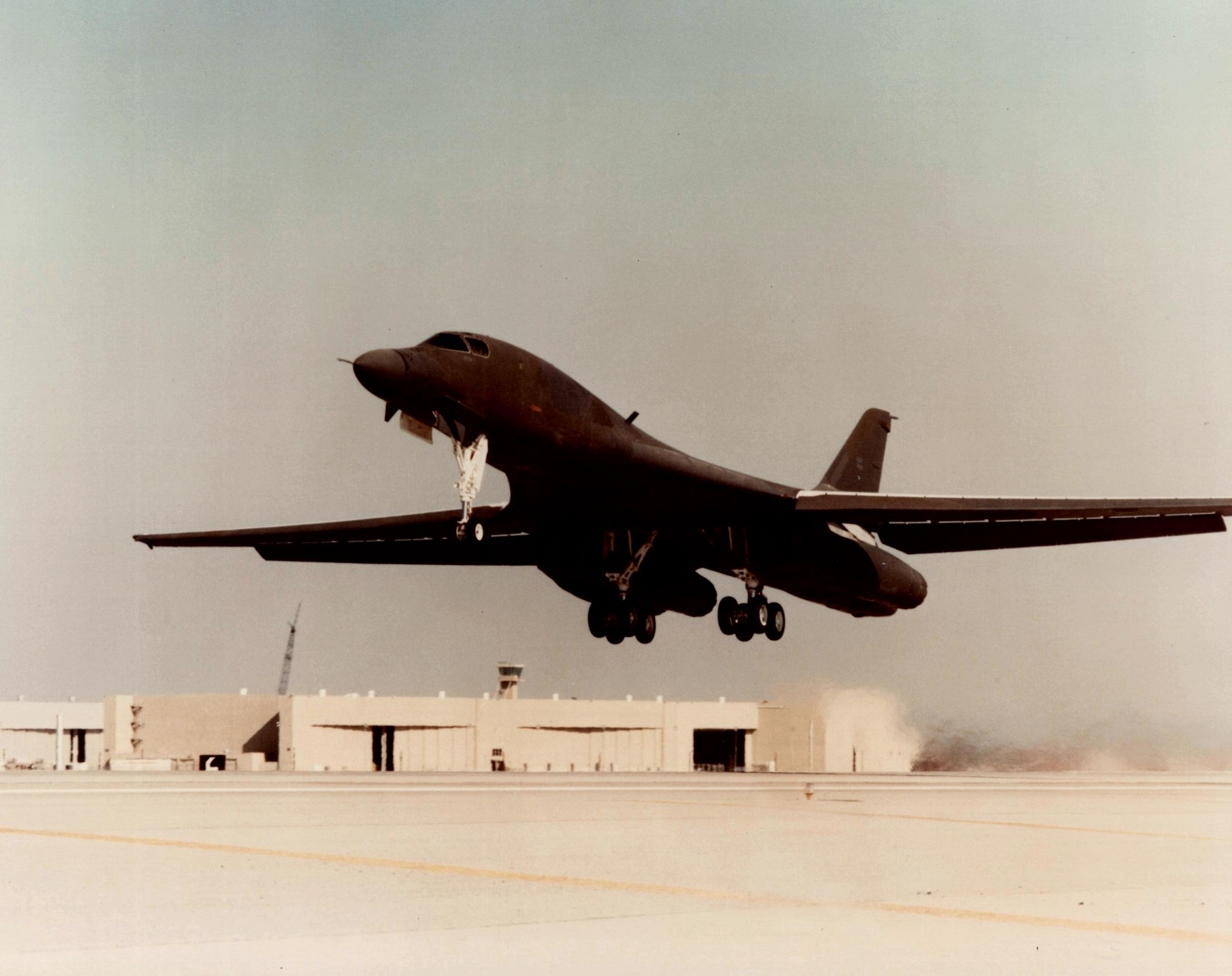

Rockwell test pilot Mervyn Leroy Evenson (Colonel, U.S.Air Force, retired) was the aircraft commander, with co-pilot Lieutenant Colonel Leroy Benjamin Schroeder; Major S.A. Henry, Offensive Systems Officer; Captain D.E. Hamilton, Defensive Systems Officer.
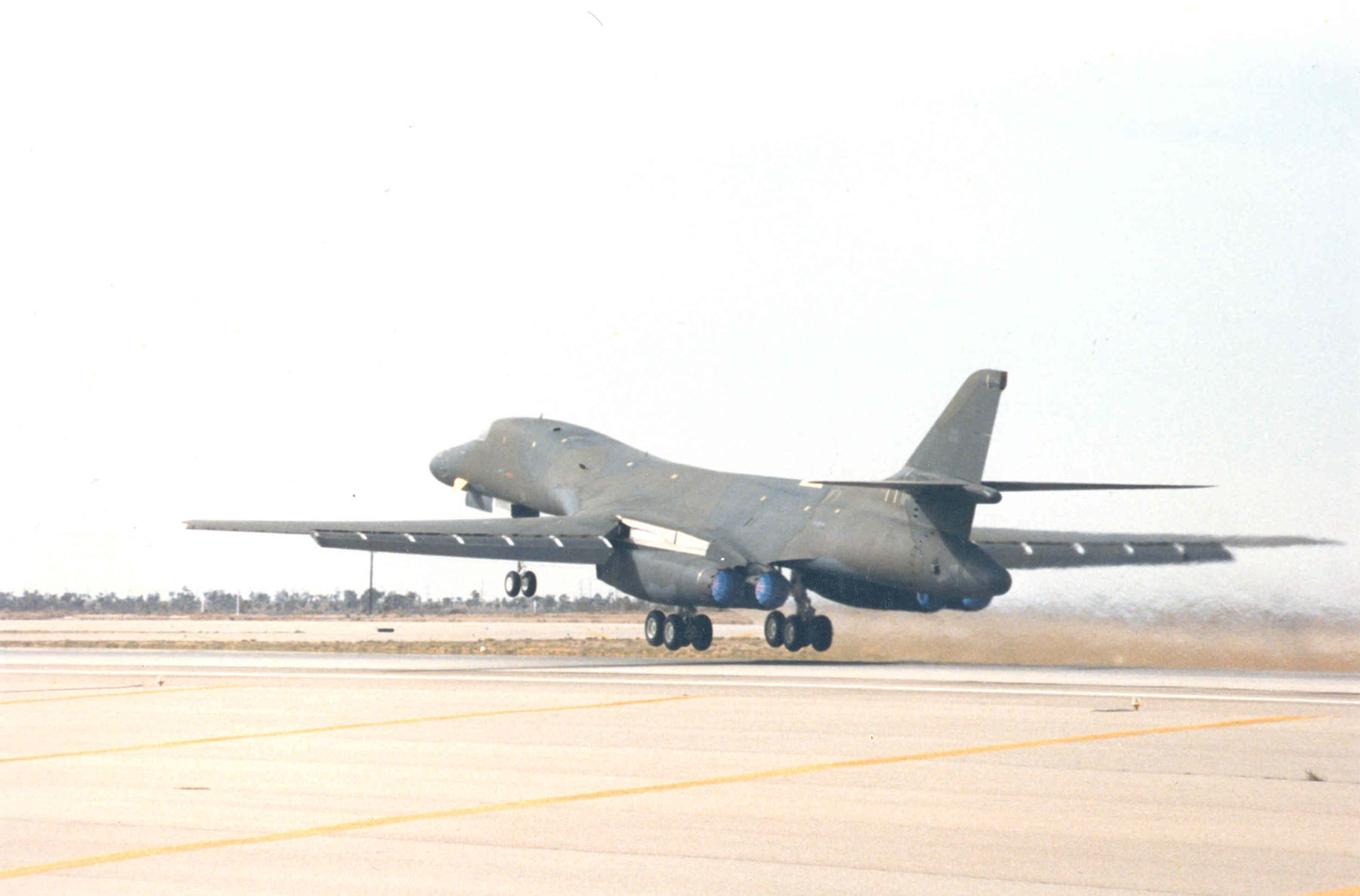
After 3 hours, 20 minutes, the B-1B landed at Edwards Air Force Base where it would enter a flight test program.
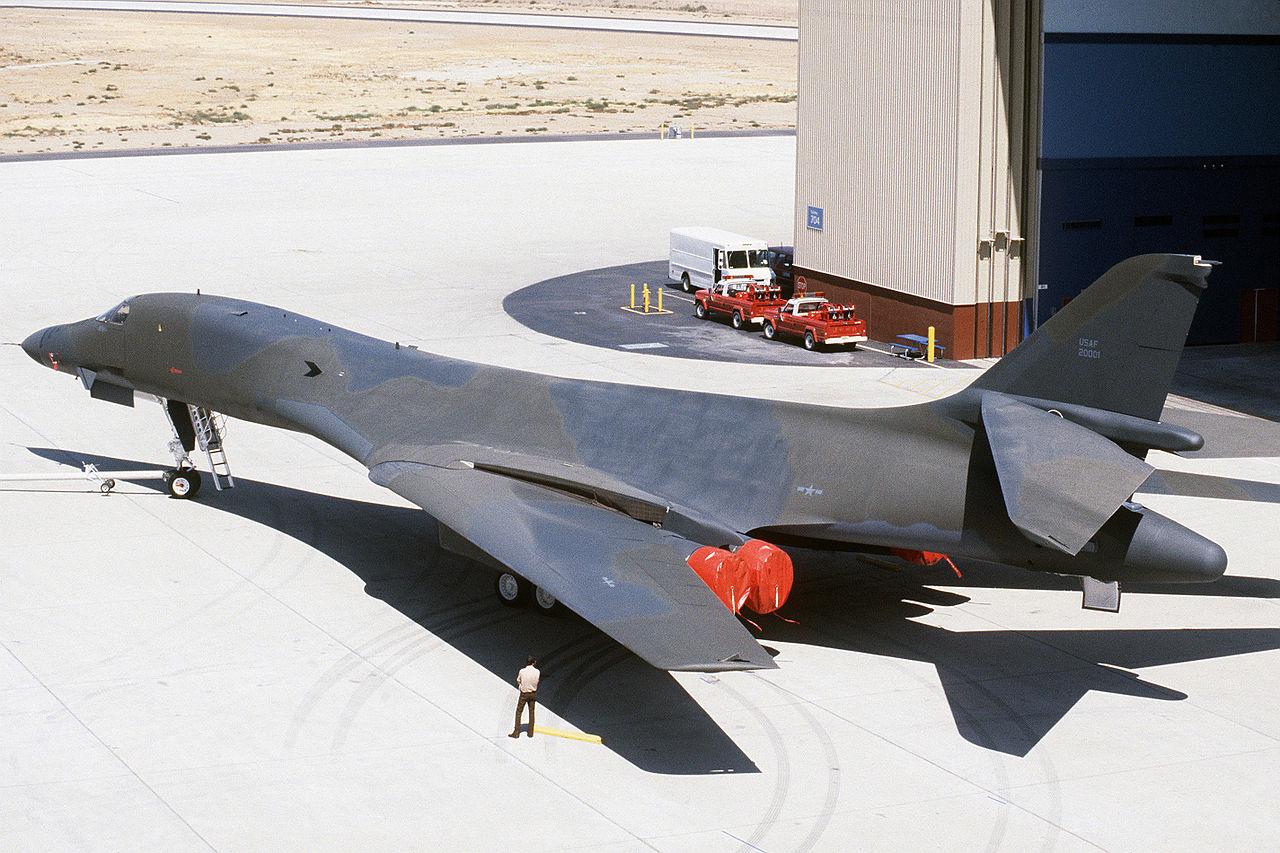
The Rockwell International B-1B Lancer is a supersonic intercontinental bomber capable of performing strategic or tactical missions. It is operated by a flight crew of four.
The B-1B is 147 feet, 2.61 inches (44.8719 meters) long, with the wing span varying from 86 feet, 8.00 inches (26.4160 meters) at 67.5° sweep to 136 feet, 8.17 inches (41.6603 meters) at when fully extended to 15° sweep. It is 33 feet, 7.26 inches (10.2428 meters) high to the top of the vertical fin. The bomber’s empty weight is approximately 180,500 pounds (81,873 kilograms). Its maximum weight in flight is 477,000 pounds (216,634 kilograms). The internal payload is up to 75,000 pounds (34,019 kilograms).

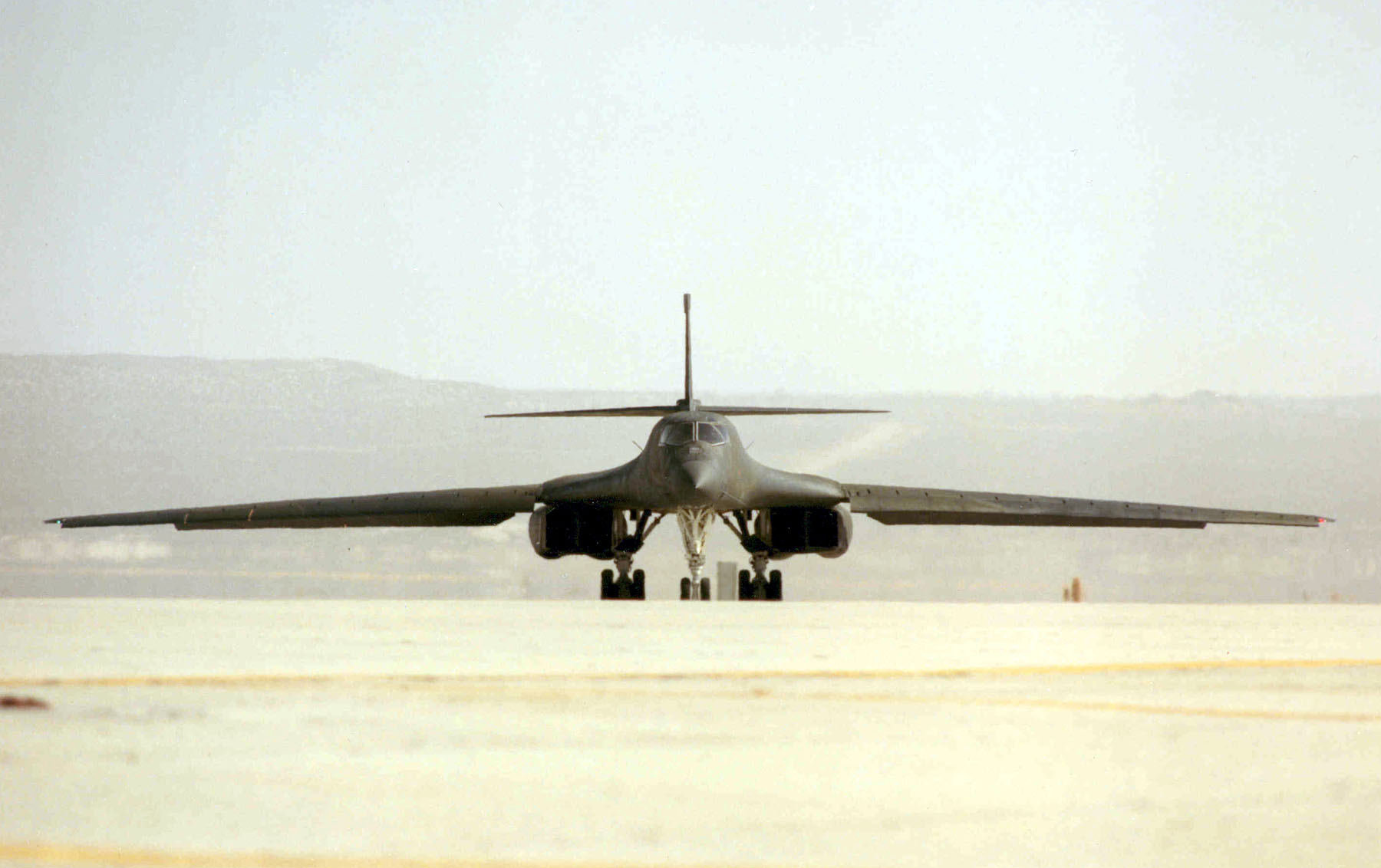
“The Bone” has a maximum speed of Mach 1.2 at Sea Level (913 miles per hour, or 1,470 kilometers per hour). The service ceiling is “over 30,000 feet” (9,144 meters). The Lancer’s maximum range is “intercontinental, unrefueled.”
It can carry up to 84 Mk.82 500-pound (226.8 kilogram) bombs, 24 Mk.84 2,000-pound (907.2 kilogram) bombs or other weapons in three weapons bays. The B-1B was built with the capability to carry 24 B61 thermonuclear bombs, though, since 2007, the fleet no longer has this capability.
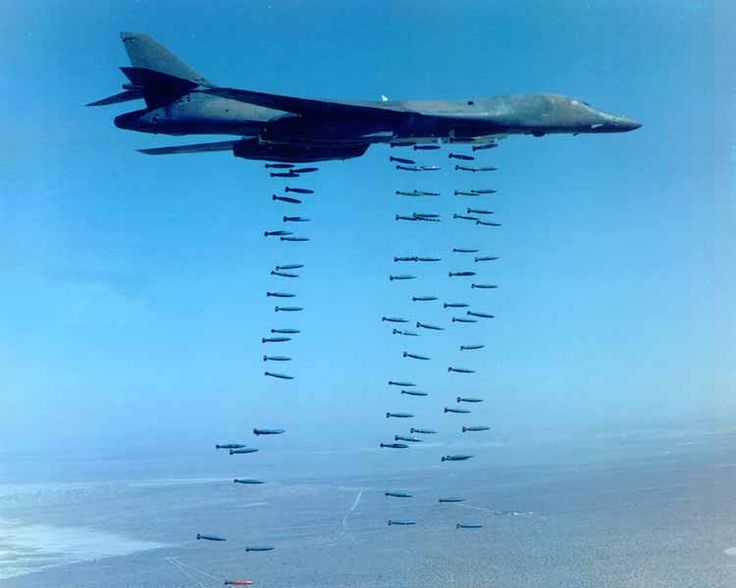
100 B-1B Lancers were built between 1983 and 1988. As of September 2021, 45 B-1B bombers remained the active Air Force inventory. The Air Force plans upgrades to the aircraft and to keep it in service until 2033.
To comply with the START weapons treaty, B-1B 82-0001 was scrapped at Ellsworth Air Force Base, South Dakota, in the mid-1990s.
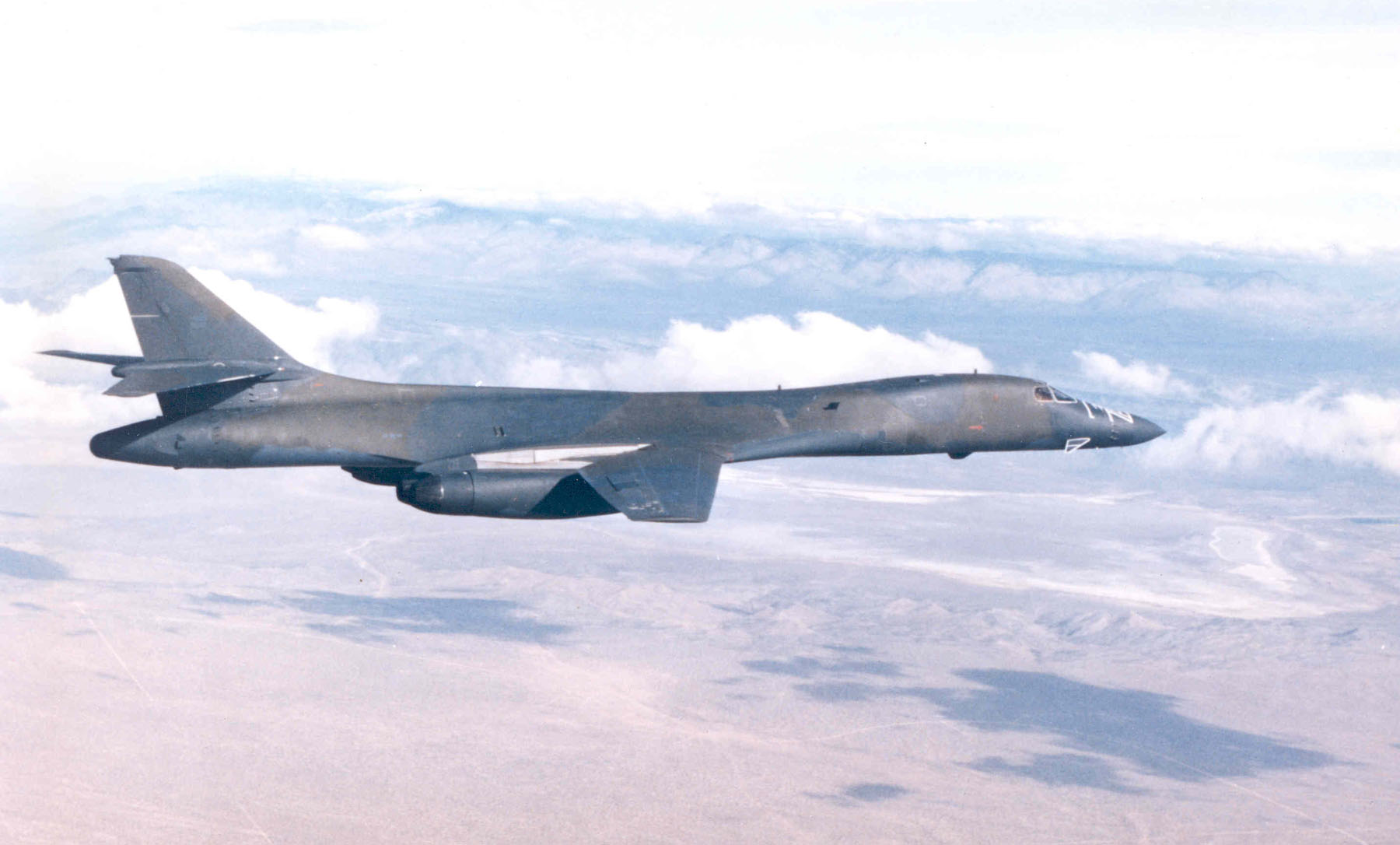
© 2018, Bryan R. Swopes
I have always wondered why historically significant aircraft get sent to the scrap heap and smelters such as 82-0001 and all of Northrup’s flying wing airframes, the XB-35’s and YB-49’s. The Smithsonian at one point even requested one of the Flying Wings for their collection, but was turned down by Secretary of the Air Force, Stuart Symington, go figure.
The prototype XP-86 Sabres were destroyed by atomic bombs at the Nevada Test Site. . . I don’t know why it is. Perhaps they were so focused on looking forward that they didn’t have time to consider that someday, they might want to look back. . . I believe that we all owe a tremendous debt of gratitude to restorers, who not only preserve historic objects, but also the technology and art of the time.
Wasn’t Symington a Senator from Missouri and specifically St. Louis, home of the Redbirds and the then Douglas Aircraft. I believe Mr. Douglas was no fan of the entire Northrop organization and he wanted no part of the entire concept and execution of the “Flying Wing” as a threat to conventional Long Fuselage, Long wingspan big bomber designs since the 1930’s. I may be confusing him with someone else who hated Northrop and its innovation and quality, which was amazing when there was no fly by wire or computer aids for flying assist.
I have heard this and several other stories about the cancellation of the Flying Wings. Also, the government had a huge investment in the bomber plant at Fort Worth and having Consolidated-Vultee build the B-36 there was considered a plus. There is also the story that Symington (a.) ordered North American Aviation to NOT break the sound barrier with the XP-86, and then after George Welch went ahead anyway, ordered it kept secret for about 6 months.
I was just reading where they are thinking of fitting a large ‘hypersonic missile’ to the B-1 externally to extend the service life beyond that 2036 date.
The 4th and final B-1A became the effective prototype for the B-1B evolution, and it is on display in the Air Force Museum at Wright-Patterson. In general, there is serious effort to preserve historically significant airplanes but sometimes it doesn’t work out.
B-1B MRR: No war, no weather, no worries says it all.
https://www.airforcetimes.com/news/your-air-force/2019/06/04/b-1-lancer-readiness-is-in-the-toilet-heres-why/
The BONE had a lot of firsts and made its own unique category that I’m not sure any other aircraft will ever beat, nor want to be in. First aircraft with its own intake ice-making/FOD-machine, first to abort down the runway on the daily flight schedule, first to be ready for the BONEyard on its first day in the inventory, first to have an IFE because the co-pilot had to recover the aircraft after blue-water blinded the AC from the toilet exploding in his face when he flushed and a near-infinite list of other undesirable characteristics. All know it, experienced permanent head aches over it, and willing to admit it, except those responsible for its incredibly poor record and non-performance
Direct observations from what I saw from flying from the same facilities, using the same airspace at both Dyess and McConnell. It was truly ridiculous and down right embarrassing for USAF operators who had a job to do. Sure you can read the hand picked morsels of % of ordinance dropped during select operations but they say nothing about the cost and effort to get the aircraft there to drop. Very little contribution and effectiveness to the overall war effort. And most of all, it used up critical resources that other highly effective weapons systems could have benefitted from. The Lancer only served to get in the way of everyone else getting their missions accomplished. She sure looked pretty sitting on the ramp though. It’s what happens when politics gets in the way of the design, development and procurement of an aircraft. Things like, let’s have a part of the aircraft built in all 50 states. Imagine the headaches that caused for the guys who had to figure out how to put it altogether.
On the other hand, some aircraft like the B-52 belong to a very special group that transcends all aircraft categories, exceeding every expectation of design, life, mission, all the -ilities, etc. Only one allowed per prefix until another proves worthy of replacing it: A-10, B-52, C-130, F-4, KC-135, P-51, SR-71, to name a few.
Brock, you nailed it. The B-1 was, is, and always will be nothing more than a piece of sh…I mean junk. A total and complete waste of money.
As a USAF pilot, I flew both the B-52 and the B-1. They are as different as night and day. The B-52 is basically a large jet powered B-17. Nothing wrong with that. It has proven to be a phenomenally successful aircraft. The B-1 is a far more complex aircraft. And much like other newer aircraft that are very complex it displays poor overall mission readiness due to this extreme level of design complexity (much like the F-22 and F-35). And I can personally attest to the overall poor build quality of the aircraft. Unacceptably poor. And due to many of its design features, it’s a maintenance nightmare. So yes, I too think the Bone has been a disappointment to the USAF. But it does provide a capability that no other aircraft provides. So it continues to serve despite the frustrations it often causes its crews and maintainers.
And unfortunately, yes the Bone was a victim of politics and poor management decision by the USAF during its design and initial life cycle. Hopefully, the Air Force learned their lesson. But looking at the F-35 development process, it appears they haven’t.
When you examine the safety record of the B-52 vs the B-1, surprisingly you will find the B-52 has a much worse accident and fatality record than does the Bone. And compared the historic B-47, the Bone is a far, far safer aircraft for the crews. Same when compared to the B-58. And if you really look into it, you will find the B-52, as awesome as it is, is not without its own set of problems.